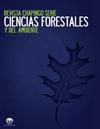热带飓风对墨西哥下加利福尼亚州圣何塞湾下游盆地和河口植被覆盖的影响
IF 0.5
4区 农林科学
Q3 Agricultural and Biological Sciences
Revista Chapingo Serie Ciencias Forestales Y Del Ambiente
Pub Date : 2020-12-01
DOI:10.5154/r.rchscfa.2020.03.011
引用次数: 2
摘要
热带飓风改变了生态系统的组成和结构。目的:分析热带飓风对植被恢复和恢复力的影响。材料与方法:通过研究2013-2017年11次热带飓风对圣何塞德尔卡波下游盆地和河口植被覆盖的影响,评价其恢复能力。分析了每个事件的陆地卫星图像和两个Lidia飓风的SPOT-6图像。通过对归一化植被指数(NDVI)变化的分析,估算了植被类型的增益、稳定、损失和恢复面积。结果与讨论:植被覆盖度的平均稳定性为90%;然而,在飓风Odile(2014)和Lidia(2017)的情况下,稳定性下降幅度较大,分别损失35.4%和20.5%,是多年生草本植被受影响最大的。奥德乐和利迪雅治疗后1年,恢复率分别为8.4%和25.4%;恢复最多的植被类型是芦苇-乔木。对SPOT-6图像的分析可以详细观察Lidia对棕榈林的影响。径流对入侵物种(柽柳和黄柳)的生长有利;此外,据估计,2017年有1.4公顷的森林被砍伐,20公顷的面积受到火灾的影响。结论:植被对热带飓风具有较强的抵御能力;然而,提供超过50%年降水量的事件会降低植被的恢复能力。本文章由计算机程序翻译,如有差异,请以英文原文为准。
Impacts of tropical hurricanes on the vegetation cover of the lower basin and estuary of San José del Cabo, Baja California Sur, Mexico
Introduction: Tropical hurricanes modify composition and structure of
ecosystems. Objective: To analyze the impact of tropical hurricanes on the recovery and
resilience of vegetation cover. Materials and methods: The resilience of the lower basin and estuary of San
Jose del Cabo was evaluated by studying the impact of 11 tropical hurricanes
(2013-2017) on the vegetation cover. Landsat images were analyzed for each
event and two SPOT-6 images for the Hurricane Lidia. The areas of gain, stability,
loss and recovery of vegetation types were estimated based on the analysis of
changes in the Normalized Difference Vegetation Index (NDVI). Results and discussion: Average stability of vegetation cover was 90 %;
however, in the case of hurricane Odile (2014) and Lidia (2017), stability
decreased considerably, with a loss of 35.4 and 20.5 %, respectively, being the
perennial herbaceous vegetation the most affected. One year after Odile and Lidia,
recovery was 8.4 % and 25.4 %, respectively; the most recovered vegetation type
was reed-tree. The analysis of SPOT-6 images allowed the detailed observation of
Lidia's effect on palm grove. The main cause of its loss was runoff from the stream,
which favored the growth of invasive species (Arundo donax L. and Tamarix sp.);
furthermore, it was estimated that 1.4 ha were deforested, and an area of 20 ha
affected by fire in 2017. Conclusion: Vegetation is resilient to tropical hurricanes; however, events that
provide more than 50 % of annual precipitation decrease the capacity of vegetation
to recover.
求助全文
通过发布文献求助,成功后即可免费获取论文全文。
去求助
来源期刊
CiteScore
1.20
自引率
16.70%
发文量
0
审稿时长
>12 weeks
期刊介绍:
The Revista Chapingo Serie Ciencias Forestales y del Ambiente (RCHSCFA) is a scientific journal that aims to raise awareness of high-quality research products related to forest, arid, temperate and tropical environments in the world. Since its foundation in 1994, the RCHSCFA has served as a space for scientific dissemination and discussion at a national and international level among academics, researchers, undergraduate and graduate students, forest managers and public/private entities that are interested in the forest environment.
All content published in the journal first goes through a strict triple-blind review process and is published in the following formats: Scientific Articles, Review Articles, Methodologies, Technical or Technological Notes.

 求助内容:
求助内容: 应助结果提醒方式:
应助结果提醒方式:


